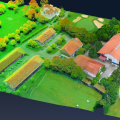
Minister for Resources and Energy, Martin Ferguson AM MP welcomed the release by Geoscience Australia last week at the spatial@gov conference of two new valuable mapping tools for use by the private sector and the general public.
The first was Digital Elevation Modelling (DEM) data @ 30m resolution and the second was a comprehensive view of Australia’s land cover.
“As the nation’s keeper of geoscience information, these releases from Geoscience Australia represent a significant step towards increasing our understanding of the continent and the changes it is undergoing,” Minister Ferguson said.
“Digital elevation data describes Australia’s landforms and is crucial for addressing issues relating to the impacts of climate change, disaster management, water security, environmental management, and urban planning and infrastructure design.
“The new 30m products improve our understanding of the national topography by producing digital elevation models at more than eighty times the resolution of the current national model.
“The new data has a vertical accuracy of + or – 9 metres and will be of particular value in determining areas were more intensive flood risk assessment is required.
The models were produced as part of a collaboration between Geoscience Australia, the Bureau of Meteorology, the Australian National University and CSIRO who have produced a number of derived products and applications such as floodplain mapping.
“Individuals and organisations using the dataset will be able to model how water flows through a particular catchment and analyse, or visualise, the interactions of specific features of interest, such as wetlands, and the impacts of land use further up the catchment,” Minister Ferguson said.
“In addition to the release of the new DEM, Geoscience Australia, with support from the Australian Bureau of Agriculture and Resource Economics and Sciences, has recently completed the first comprehensive national map of Australia’s land cover, giving land and resource managers and researchers the opportunity to analyse changing trends in Australia’s vegetation cover.
Land cover is the observed biophysical cover on the Earth’s surface including trees, shrubs, grasses, soils, exposed rocks and water bodies, as well as anthropogenic elements such as plantations, crops and built environments.
“Australia’s land cover changes constantly due to weather, seasonal changes and land use, so nationally consistent land cover information is essential to understanding and addressing a range of natural resource challenges. These include sustainable farming practices, management of our water resources, air quality, soil erosion, and our forests”, Minister Ferguson said.
“The land cover map and dataset will allow users to compare vegetation over time, at a national and local level, to monitor trends associated with short term changes brought on by cyclones, long term drought and bushfires, as well as cropping and broadacre agriculture.
“Future updated versions of the map will identify actual changes in the land cover which could provide evidence of a need for action in areas such as water management and soil erosion, or that patterns of land use are changing due to economic, climatic or other factors.”
Both datasets are now available free online via the Geoscience Australia website, or at cost of transfer from the online Geoscience Australia Sales Centre. Hard copies of the land cover map are available free of charge from the Geoscience Australia Sales Centre.







